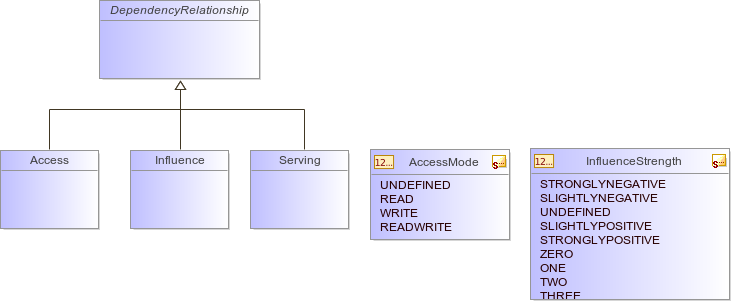
ArchiMate Metamodel
Dependency relationships describe how elements support or are used by other elements. Three types of dependency relationship are distinguished:
- The serving relationship represents a control dependency, denoted by a solid line.
- The access relationship represents a data dependency, denoted by a dashed line.
- The influence relationship is the weakest type of dependency, used to model how motivation elements are influenced by other elements.
Note that, although the notation of these relationships resembles the notation of the dependency relationship in UML, these relationships have distinct meanings in ArchiMate notation and (usually) point in the opposite direction.
One advantage of this is that it yields models with directionality, where most 2 of the arrows that represent such supporting, influencing, serving, or realizing dependencies point 'upwards' towards the client/user/business.
Another reason for this direction, in particular for the serving relationship, is that it abstracts from the 'caller' or 'initiator', since a service may be delivered proactively or reactively.
The direction of delivery is always the same, but the starting point for the interaction can be on either end.
UML's dependency is often used to denote the latter, showing that the caller depends on some operation that is called. However, for modeling this type of initiative, the ArchiMate language provides the triggering relationship, which can be interpreted as a dynamic (i.e., temporal) dependency. Similarly, the flow relationship is used to model how something (usually information) is transferred from one element to another, which is also a dynamic kind of dependency.


Class | Summary |
|---|---|
The access relationship models the ability of behavior and active structure elements to observe or act upon passive structure elements. | |
The influence relationship models that an element affects the implementation or achievement of some motivation element in a positive or negative way. | |
The serving relationship models that an element provides its functionality to another element. |
Enumeration | Values | Description |
|---|---|---|
AccessMode | UNDEFINED READ WRITE READWRITE | Determines where the Access relationship arrowheads appear. The graphic notation will point in the opposite direction of the metamodel direction to denote 'read' access, and in both directions to denote read-write access.
|
InfluenceStrength | STRONGLYNEGATIVE SLIGHTLYNEGATIVE UNDEFINED SLIGHTLYPOSITIVE STRONGLYPOSITIVE ZERO ONE TWO THREE FOUR FIVE SIX SEVEN EIGHT NINE TEN | Defines the possible values of Influence relationships. By default, the influence relationship models a contribution with unspecified sign and strength. Values are sorted from the most negative to the most positive one. |